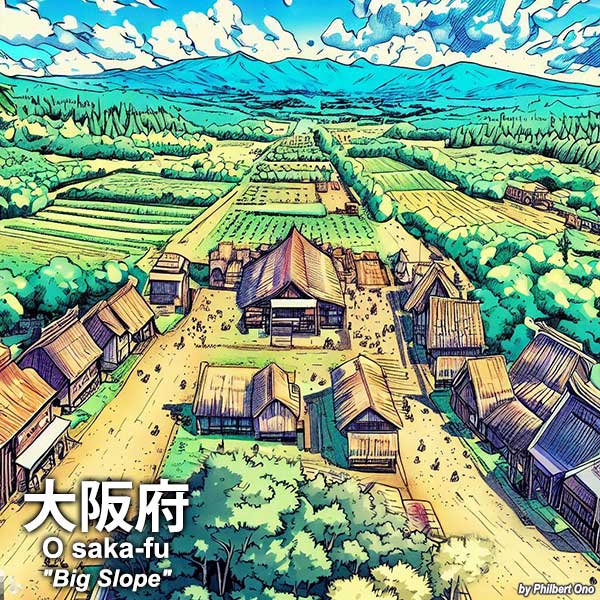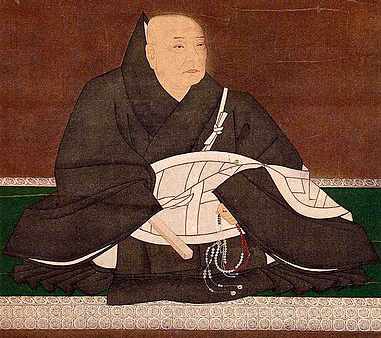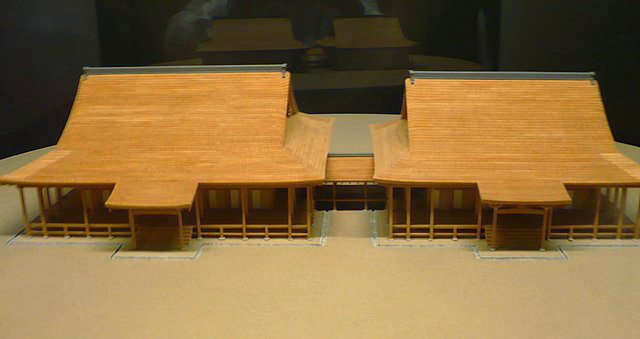OSAKA – Big Slope 大阪府


The name “Osaka” can be largely credited to Rennyo (蓮如 1415–1499), the 8th Chief Abbot (Monshu) of the Jodo Shinshu Hongwanji-ha Buddhist sect.
He built a small Buddhist hall or dojo called Ozaka Gobo (大坂御坊) as his retirement home in 1497 where Osaka Castle is located today. Some of his followers also built homes nearby.
Rennyo wrote the earliest known document where the Ōsaka/Ōzaka kanji characters (大坂) appear. It was a doctrinal newsletter (ofumisho 御文章) for his adherents written in 1496. The newsletter was addressed to people in “Ōzaka” written as 大坂.
“Osaka” variants such as “Ohosaka” (オホサカ) and “Wosaka” (ヲサカ) and variant kanji characters like 小坂 (Small Slope) and 尾坂 (Tail Slope) have been found in other documents.
The area destined to become central Osaka was a large, sloping plateau originally a sandbar formed by adjacent rivers. It was a marshy peninsula full of reeds jutting into Osaka Bay. It’s one of Osaka Prefecture’s oldest inhabited areas formerly called “Naniwa-gata” (Naniwa inlet or lagoon 難波潟). Naniwa was written in kanji variants such as 浪速 (also pronounced “Namihaya”), 難波, 浪花, and 浪華.
Naniwa was the Imperial capital a few times as early as the 5th century. The site of the Naniwa-no-miya Palace (難波宮) from the 7th to 8th centuries is now a public park.
Naniwa was also a major port (Suminoe-tsu 住吉津 and Naniwa-tsu 難波津 ) for domestic and overseas ships for trade and diplomacy with China and Korea. Now you know why we often see the name “Naniwa” or “Nanba” in Osaka. It’s central Osaka’s old name.
By 1533, Rennyo’s modest Ōzaka Buddhist hall evolved into the mighty, fortress-like Ishiyama Honganji Temple (also called “Ōzaka Honganji” 石山本願寺, 大坂本願寺).
Along with the temple’s prominence, the name “Ōzaka” (大坂) came into common use. The temple town that developed around the temple greatly contributed to the development of Osaka as a population center.

“Ishiyama” (石山) means “stone mountain,” and there’s some debate among historians regarding the origin of this name. Rennyo’s grandson, warrior-monk Kensei (顕誓), wrote in 1568 that Ishiyama was probably named after the large stones miraculously found in the ground which served as the building’s foundation.
However, modern archaeological excavations found that the temple/castle site was also the site of Naniwa-no-miya Palace (難波宮) during the 7th to 8th centuries as the emperor’s residence. This has convinced historians that the “Ishiyama Honganji Temple” name may have been created after the temple’s demise and the actual name was “Ōzaka Honganji.”
The temple became a major base for Ikko-ikki warrior monks opposing the samurai government until top warlord Oda Nobunaga finally successfully captured the temple in 1580 after 10 years of conflict.
After getting assassinated, Nobunaga was succeeded by his top general Toyotomi Hideyoshi who built Osaka Castle in 1583 as his base on the site of Ishiyama Honganji. His castle further developed Osaka as a major population center.
During the Edo Period, both the Ōzaka and Ōsaka pronunciations were used and even the 小坂 kanji (Small Slope) was used with a short O sound.
The “big slope” meaning of “Ōzaka/Ōsaka” refers to Uemachi Plateau (上町台地) which stretches 11 km north to south and 2 km to 3 km east to west. Uemachi Plateau is defined as the area from Tenmabashi Bridge (天満橋) across Okawa River (Kyu-Yodo River) near Osaka Castle in the north to Oriono Bridge (遠里小野橋) across Yamato River in the south not far from Sumiyoshi Taisha Shrine.
The plateau’s northern end has the highest elevation of 32 meters (around Osaka Castle), and the southern end has 19-meter elevation. So it is indeed a big slope, but it’s hard to discern this sloping landscape since it’s gradual and covered with tall buildings.
Uemachi Plateau encompasses much of central Osaka including Osaka Castle, Chuo Ward, Tennoji Ward, Abeno Ward, Shitennoji Temple, Tsutenkaku Tower, and Sumiyoshi Taisha Shrine.
In the late 19th century, the Meiji government changed the “saka” kanji character in “Ōsaka” from 坂 to the current 阪. There are two major theories regarding the reason for this change:
Theory 1: The 坂 kanji consists of kanji radicals 土 (soil) and 反り (return) which could mean “土に反る” (tsuchi ni kaeru = return to the earth) associated with death.
Theory 2: The 坂 kanji consists of kanji radicals 士 (warrior) and 反り (return) which could mean “士が反する” (shi ga hansuru = samurai shall rebel) associated with disobedience to the new Meiji government.
However, even when Osaka Prefecture was first established, there were official seals using both 大阪 and 大坂, so the change might have had more casual reasons. The official pronunciation was also set to “Ōsaka” instead of “Ōzaka.”
When I studied Japanese language in college, our teacher told us that the saka kanji (阪) in “Osaka” is basically only seen in “Osaka.” It’s not used for anything else (except maybe the corporate name Hankyu 阪急). He was right.
Old province names: Settsu-no-Kuni, Izumi-no-Kuni, Kawachi-no-Kuni (摂津国+和泉国+河内国)
*The AI-generated image is for illustrative purposes only and may not accurately depict any particular place in the prefecture.
Sources: https://ja.wikipedia.org/wiki/%E5%A4%A7%E9%98%AA
Origin of other prefectural names (etymologies)
Overview | Aichi | Akita | Aomori | Chiba | Ehime | Fukui | Fukuoka | Fukushima | Gifu | Gunma | Hiroshima | Hokkaido | Hyogo | Ibaraki | Ishikawa | Iwate | Kagawa | Kagoshima | Kanagawa | Kochi | Kumamoto | Kyoto | Mie | Miyagi | Miyazaki | Nagano | Nagasaki | Nara | Niigata | Oita | Okayama | Okinawa | Osaka | Saga | Saitama | Shiga | Shimane | Shizuoka | Tochigi | Tokushima | Tokyo | Tottori | Toyama | Wakayama | Yamagata | Yamaguchi | Yamanashi